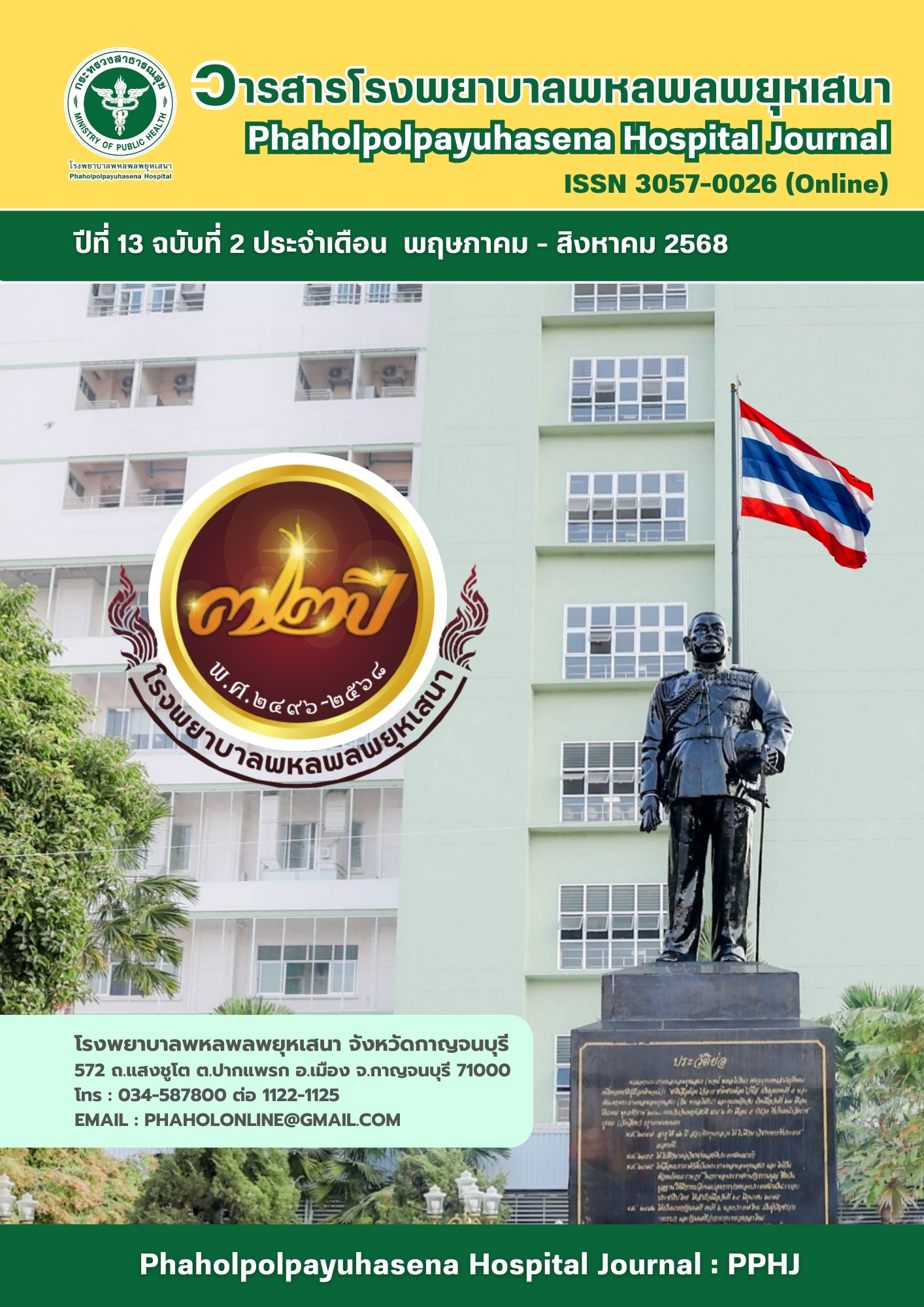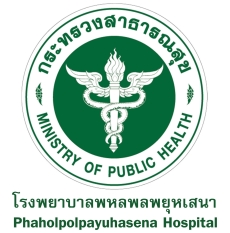A Comparison Between 0.1 and 0.2 mg of Intrathecal Morphine for Caesarean Section on Postoperative Pruritus in Phaholpolpayuhasena Hospital: A randomized, double-blinded, controlled trial
Keywords:
caesarean section, spinal morphine, pruritus, nausea and vomiting, painAbstract
Objective: To compare the incidence of pruritus, nausea and vomiting, and pain scores between groups receiving 0.1 mg and 0.2 mg intrathecal morphine in pregnant women undergoing cesarean section under spinal anesthesia at Phaholpolpayuhasena Hospital.
Methods: This was a prospective, double-blinded, randomized controlled trial conducted on pregnant women undergoing non-emergency cesarean section under spinal anesthesia at Phaholpolpayuhasena Hospital between February and April 2025. A total of 72 participants were randomly allocated into two groups of 36 each using block randomization. The incidence of pruritus, nausea and vomiting, and average pain scores were compared at time intervals of 0–2, 2–12, and 12–24 hours post-administration. Data were analyzed using the chi-square test and independent t-test,
Results: The incidence of pruritus showed no significant difference between groups at all time intervals (2.78, 52.78, 30.56% vs 11.11, 69.44, 38.89%, respectively), although a decreasing trend was observed in the 0.1 mg group. Nausea and vomiting incidence at 0–2 and 2–12 hours did not differ between the groups. However, during the 12–24-hour period, the 0.1 mg group had a significantly lower incidence of nausea and vomiting (0 vs 13.89%; p=0.020). The average pain scores and analgesic use did not differ between the groups.
Conclusion: Reducing the intrathecal morphine dose to 0.1 mg did not significantly reduce pruritus but clearly decreased nausea and vomiting during the 12–24hour period, without compromising pain control. Therefore, a lower dose may help minimize side effects while maintaining analgesic efficacy.
References
Kumar K, Singh SI. Neuraxial opioid-induced pruritus: An update. Journal of Anesthesiology Clinical Pharmacology. 2013;29(3):303–7.
Becker LM, Teunissen AJW, Koopman JS. Prevention and treatment of neuraxial morphine-induced pruritus: A scoping review. Journal of Pain Research. 2022;15:1633–45.
Cardoso MM, Carvalho JC, Amaro AR, Prado AA, Cappelli EL. Small doses of intrathecal morphine combined with systemic diclofenac for postoperative pain control after cesarean delivery. Anesth Analg. 1998;86(3):538–41.
Sarvela J, Halonen P, Soikkeli A, Korttila K. A double-blinded, randomized comparison of intrathecal and epidural morphine for elective cesarean delivery. Anesth Analg. 2002;95(2):436–40.
Thay YJ, Goh QY, Han RN, Sultana R, Sng BL. Pruritus and postoperative nausea and vomiting after intrathecal morphine in spinal anesthesia for caesarean section: Prospective cohort study. Proceedings of Singapore Healthcare. 2018;27(4):251–5.
Szarvas S, Harmon D, Murphy D. Neuraxial opioid-induced pruritus: a review. Journal of Clinical Anesthesia. 2003;15(3):234–9.
Palmer Craig M, Emerson S, Volgoropolous D, Alves D. Dose-Response Relationship of Intrathecal Morphine for Postcesarean Analgesia. Anesthesiology. 1999;90(2):437–44.
Gerancher JC, Floyd H, Eisenach J. Determination of an Effective Dose of Intrathecal Morphine for Pain Relief After Cesarean Delivery. Anesth Analg. 1999;88(2):346–51.
Girgin NK, Gurbet A, Turker G, Aksu H, Gulhan N. Intrathecal morphine in anesthesia for cesarean delivery: dose-response relationship for combinations of low-dose intrathecal morphine and spinal bupivacaine. Journal of Clinical Anesthesia. 2008;20(3):180–5.
Uchiyama A, Nakano S, Ueyama H, Nishimura M, Tashiro C. Low dose intrathecal morphine and pain relief following caesarean section. International Journal of Obstetric Anesthesia. 1994;3(2):87–91.
จีระนาถ ศรีวรมาศ, วิมลมาน ว่องไว, ญาณินทร สมเนตร. การศึกษาเปรียบเทียบอาการคันระหว่างการใช้มอร์ฟีน 0.1 มิลลิกรัมและ 0.2 มิลลิกรัม เข้าช่องนํ้าไขสันหลัง สําหรับการผ่าตัดคลอดในโรงพยาบาลสรรพสิทธิประสงค์ จังหวัดอุบลราชธานี. วิสัญญีสาร. 2013;39(3):171–182.
Jacobs NF, Veronese LR, Okano S, Hurst C, Dyer RA. The incidence of postoperative nausea and vomiting after caesarean section in patients with hyperemesis gravidarum: a retrospective cohort study. International Journal of Obstetric Anesthesia. 2020;44:81–9.
Dahl JB, Jeppesen IS, Jørgensen H, Wetterslev J, Møiniche S. Intraoperative and Postoperative Analgesic Efficacy and Adverse Effects of Intrathecal Opioids in Patients Undergoing Cesarean Section with Spinal Anesthesia. Anesthesiology. 1999;91(6):1919–27.
Aly M, Ibrahim A, Farrag W, Abdelsalam K, Mohamed H, Tawfik A. Pruritus after intrathecal morphine for cesarean delivery: incidence, severity and its relation to serum serotonin level. International Journal of Obstetric Anesthesia. 2018;35:52–6.
Abboud TK, Dror A, Mosaad P, Zhu J, Mantilla M, Swart F, et al. Mini-dose intrathecal morphine for the relief of post-cesarean section pain: safety, efficacy, and ventilatory responses to carbon dioxide. Anesth Analg. 1988;67(2):137–43.
Milner AR, Bogod DG, Harwood RJ. Intrathecal administration of morphine for elective Caesarean section: a comparison between 0.1 mg and 0.2 mg. Anaesthesia 1996;51(9):871–3.
Orarat Karnjanawanichkul, Jatuporn Pakpirom, Thitiporn Pueaksuwan, Sasikaan Nimmaanrat, Niranuch Siripunt, Sukanya Keawsridam. Different Doses of Intrathecal Morphine on Postoperative Analgesia and Pruritus after Cesarean Section: a Prospective Randomized Triple-Blinded Trial. PSU Medical Journal. 2022;2(3):109–20.
Abouleish EI, Rashid S, Haque S, Giezentanner A, Joynton P, Chuang AZ. Ondansetron versus placebo for the control of nausea and vomiting during Caesarean section under spinal anaesthesia. Anaesthesia. 1999;54(5):479–82.
Inthigood N, Lertbunnaphong T, Jaishuen A. Efficacy of a single 40-mg intravenous dose of parecoxib for postoperative pain control after elective cesarean delivery: A double-blind randomized placebo-controlled trial. Journal of Obstetrics and Gynaecology Research. 2016;43(1):92–9.
Downloads
Published
How to Cite
Issue
Section
License
Copyright (c) 2025 Phaholpolpayuhasena Hospital

This work is licensed under a Creative Commons Attribution-NonCommercial-NoDerivatives 4.0 International License.
บทความที่ได้รับการตีพิมพ์เป็นลิขสิทธิ์ของโรงพยาบาลพหลพลพยุหเสนา
ข้อความที่ปรากฏในบทความแต่ละเรื่องในวารสารวิชาการเล่มนี้เป็นความคิดเห็นส่วนตัวของผู้เขียนแต่ละท่านไม่เกี่ยวข้องกับโรงพยาบาลพหลพลพยุหเสนาและบุคลากรท่านอื่น ๆ ในโรงพยาบาลฯ แต่อย่างใด ความรับผิดชอบองค์ประกอบทั้งหมดของบทความแต่ละเรื่องเป็นของผู้เขียนแต่ละท่าน หากมีความผิดพลาดใด ๆ ผู้เขียนแต่ละท่านจะรับผิดชอบบทความของตนเอง



 Phaholpolpayuhasena Hospital
Phaholpolpayuhasena Hospital
